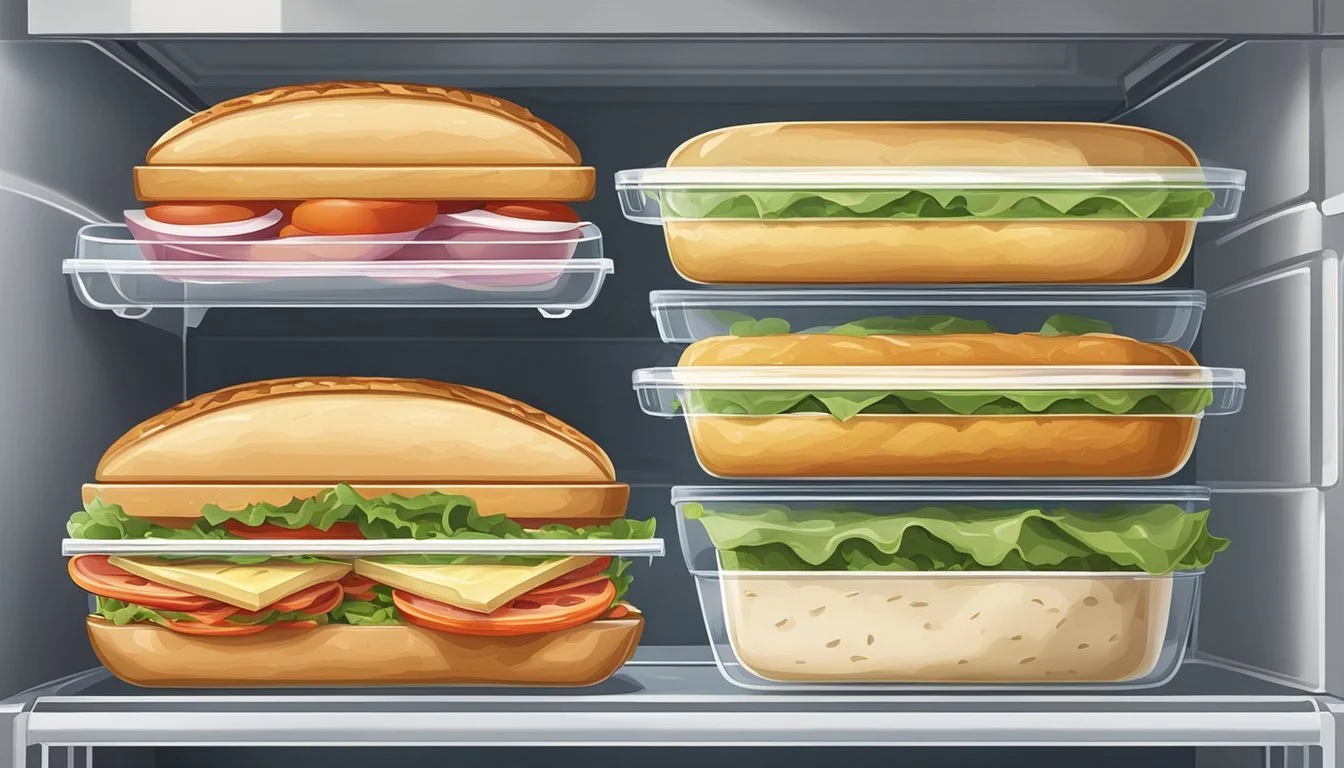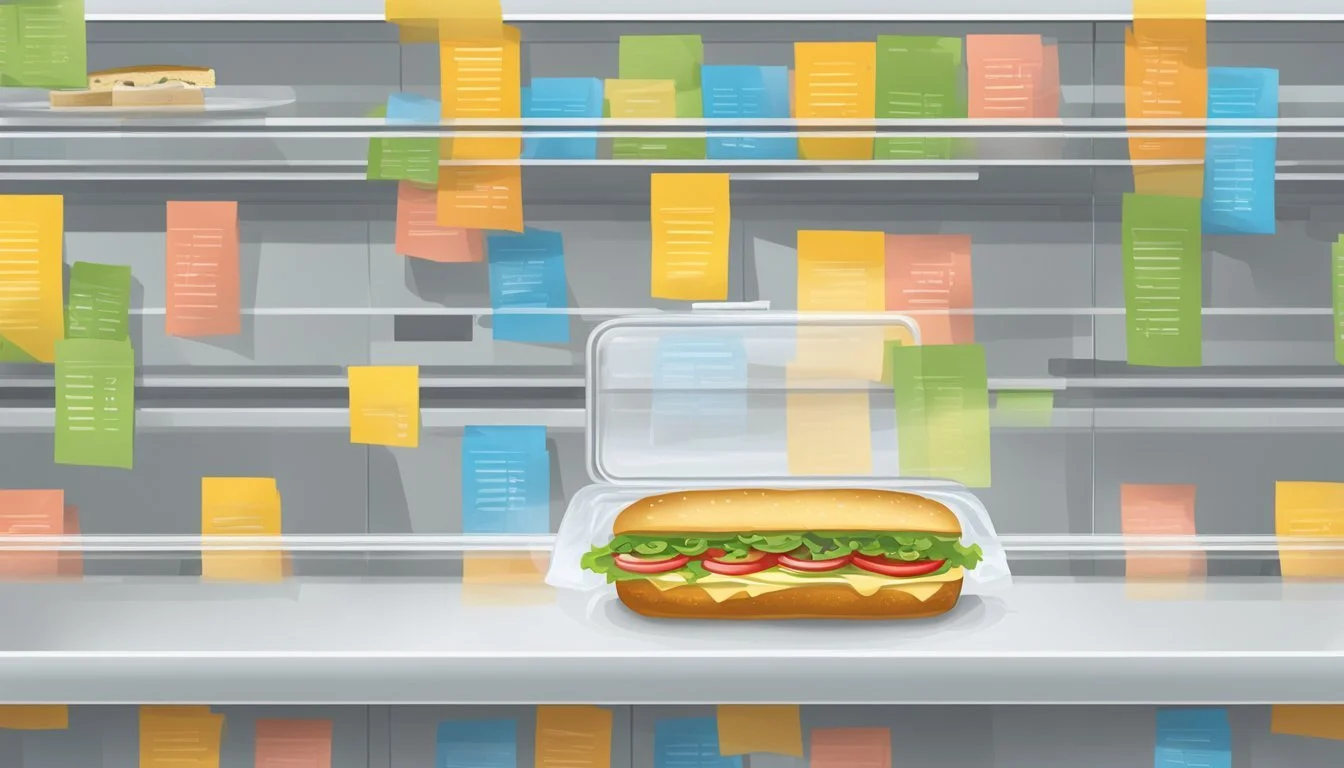How Long Do Freshly Made Sandwiches Last?
Shelf Life and Storage Tips
The shelf life of freshly made sandwiches (What wine goes well with sandwiches?) largely depends on their ingredients and storage conditions. Generally, sandwiches with dry and less perishable fillings, such as hard cheeses and vegetables like shredded cabbage and carrots, tend to last longer. These can typically be refrigerated for 3 to 5 days. Bread type is also a factor, with whole grain breads often having a shorter lifespan than white bread due to quicker moisture absorption leading to potential spoilage.
A sandwich's freshness is also affected by the preparation method and how it's wrapped before refrigeration. Wrapping a sandwich in parchment or waxed paper can prevent sogginess by allowing some air circulation while also retaining moisture content, avoiding the dryness often caused by overexposure to air. Properly stored, meat and chicken sandwiches maintain their quality for an average of 4 days in the fridge.
It's imperative for one to store sandwiches correctly to maintain freshness and safety. While sandwiches can be refrigerated, they should be consumed within the suggested time frame and checked for any signs of spoilage such as off-smell or visible mold before eating. If a longer storage time is needed, they can be frozen, although this may affect their texture and taste.
Understanding Sandwich Shelf Life
The longevity of a sandwich in the fridge is determined by its ingredients and how it's stored. It typically ranges from 3 to 5 days, influenced by factors such as moisture level and ingredient perishability.
Factors Affecting Freshness
Ingredients: The type of ingredients used in a sandwich greatly affects its shelf life. Dry ingredients like hard cheeses and tough greens maintain quality longer, while sandwiches with meat, chicken, or moist vegetables spoil quicker.
Moisture: Moisture is a key player in sandwich spoilage. Ingredients that have high moisture content can hasten bacterial growth, reducing a sandwich's longevity.
Temperature: To maximize freshness, sandwiches should be stored at a consistent temperature of 40°F (4°C) or below, as fluctuations can lead to spoilage.
Storage: Properly wrapping a sandwich in airtight packaging can protect it from contaminants and moisture, helping to prolong its shelf life.
Identifying Spoilage Signs
Mold: Visible mold, usually green or black spots, is a clear indicator that a sandwich is no longer safe to eat.
Smell: An off, sour, or otherwise unpleasant smell emanating from the sandwich is a warning signal of spoilage.
Texture: Any sliminess or unusual softness, particularly in bread, is a sign that a sandwich has deteriorated.
Taste: Should a sandwich display no visible or olfactory signs, but the taste is off, it should not be consumed.
Preparation and Ingredient Selection
The shelf life of a sandwich largely depends on the freshness of its ingredients and how they're prepared. Selecting high-quality, fresh ingredients is crucial, and understanding how different components affect a sandwich's longevity can help extend its edibility.
Choosing Fresh Ingredients
Fresh ingredients are the cornerstone of a good sandwich and play a vital role in how long it will last in the fridge. Ingredients such as meat, cheese, and vegetables should be fresh at the time of sandwich preparation to maximize shelf life. When selecting meat, one should opt for freshly sliced deli meats rather than those nearing their expiration date. With cheese, firmer varieties like cheddar or Swiss tend to last longer than softer cheeses.
Impact of Wet Ingredients on Longevity
Wet ingredients like mayo, mustard, tomato, and lettuce can significantly shorten a sandwich's refrigerator life due to moisture content. Excess moisture from these ingredients can cause sogginess and promote bacterial growth. Applying a thin layer of butter or mayo directly onto the bread can create a barrier that helps to prevent moisture from wet ingredients seeping in. This method can help to maintain the sandwich's texture and integrity for a more extended period.
Wet Ingredients: Tomato, Lettuce, Mayo, Mustard
Moisture Protection: Butter, Mayo
Bread Selection: Opt for dry, less perishable bread varieties
To further extend the sandwich's lifespan, store it properly by wrapping it in parchment paper, which allows for breathability and reduces condensation, compared to plastic wrap or aluminum foil.
Proper Storage Techniques
When storing freshly made sandwiches, the choice of environment and materials used for wrapping is central in determining the shelf life and freshness of the sandwiches.
Refrigeration vs. Room Temperature
Refrigeration is preferred for most types of sandwiches, especially those with perishable ingredients like meat, chicken, or dairy products. A refrigerator set to below 40°F (4°C) is ideal as it preserves the quality of the sandwiches and prolongs shelf life, typically allowing them to last between 3-5 days.
At room temperature, sandwiches should only be kept for a couple of hours, depending on the filling. Room temperature storage is not recommended for long-term preservation as it does not inhibit bacterial growth effectively.
Containers and Wrapping
Choosing the right type of containers and wrapping is essential for keeping sandwiches fresh:
Parchment paper or wax paper is a good choice for wrapping sandwiches as it allows the bread to breathe, preventing the sandwich from getting soggy due to condensation.
For added protection, one can also wrap the parchment-paper-wrapped sandwich in aluminum foil. However, foil alone can lead to dryness if used as the only wrapping material.
Airtight containers or Tupperware are effective in keeping out excess air and can be used in both refrigeration and freezing scenarios.
Sealable plastic bags can be used, but mind the potential for condensation build-up which could make the sandwiches soggy.
When planning to freeze sandwiches, ensure all air is removed from the container or sealable plastic bag to prevent freezer burn. Frozen sandwiches can be stored in the freezer for up to a month.
Sandwiches stored in a lunch bag should ideally be consumed within a few hours, as these bags do not provide sufficient insulation or temperature control for longer periods.
Extending Shelf Life Through Freezing
Freezing sandwiches is a reliable method to preserve their freshness and taste for longer periods. It allows one to enjoy the convenience of ready-made meals while minimizing food waste.
Freezing and Defrosting Sandwiches
When freezing sandwiches, one should ensure that the ingredients used will withstand the freezing process without compromising the quality. Ingredients such as mayonnaise, lettuce, and tomatoes are not suitable for freezing and should be avoided. Sandwiches should be tightly wrapped in cling film, aluminum foil, or placed in freezer-safe bags to prevent freezer burn. To defrost, transfer the sandwich to the refrigerator overnight, ensuring it thaws evenly and maintains its taste.
Best Practices for Freezer Storage
Wrap Each Sandwich Individually: This helps maintain the taste and texture of the bread and filling.
Label with Date: It's essential to keep track of how long sandwiches have been in the freezer to ensure they are consumed when at their best quality.
Avoid Contamination: Sandwiches should be stored away from raw foods and strong odors to maintain their freshness.
Consume Within a Recommended Time Frame: Ideally, one should consume frozen sandwiches within 1 month to enjoy optimal freshness and taste.
Safety Concerns and Consumption Guidelines
When storing and consuming sandwiches, safety is paramount to prevent foodborne illness. Understanding the impact of factors like storage temperature, types of fillings, and the presence of bacteria ensures sandwiches stay safe for consumption.
Preventing Foodborne Illness
The risk of foodborne illness increases when sandwiches are exposed to the "danger zone" temperatures between 40°F and 140°F, which allows bacteria to proliferate. It's essential to store sandwiches in a refrigerator at or below 40°F (Safety Tip: Always refrigerate within 2 hours of preparation). For sandwiches with deli meats, such as turkey, chicken, or ham, their safety can be compromised by bacteria like Listeria monocytogenes, a concern especially for vulnerable groups including pregnant women, young children, and the elderly.
To minimize risks:
Handwashing: Always wash hands before preparing sandwiches.
Ingredients: Use fresh, well-washed vegetables and properly handled meats.
Cross-contamination: Separate raw and cooked ingredients.
Determining Safe Consumption Window
The safe window for consuming sandwiches differs based on ingredients and refrigeration. A freshly made sandwich typically lasts in the refrigerator for about 3 to 5 days. Variances in fillings such as meats, sauces, and vegetables necessitate attention to changes in texture and odor as indicators of spoilage.
Fillings with higher moisture content (like tomatoes or cucumbers) may shorten a sandwich's shelf life due to faster textural changes and potential spoiling.
Sturdier ingredients (e.g., hard cheeses and cured deli meats) can extend the safe consumption window.
Recipe-specific guidelines can further advise on longevity. For example, a basic turkey and cheese sandwich may remain consumable for up to 5 days in the fridge, while additions like mayonnaise or leafy greens may warrant a shorter timeframe. Always inspect for unpleasant odors or changes in texture before eating, as these are reliable signs that a sandwich should no longer be consumed.
Additional Tips for Sandwich Longevity
When looking to preserve the integrity of a sandwich for future enjoyment, two critical elements to consider are enhancing the flavors for later consumption and selecting suitable packaging, especially for travel.
Enhancing Flavors for Later Consumption
For sandwiches expected to be consumed later, choosing ingredients that maintain or even improve their flavor over time is crucial. A sandwich with kale and carrots, for instance, can retain a pleasing crunch and taste. When using ingredients like ham, egg salad, or tuna (What wine goes well with tuna?) salad, it's best to keep components separate until it's time to eat, as this prevents sogginess. Toasting the bread can add a protective layer that minimizes moisture absorption.
Suggestions for Flavor Retention:
Toast bread lightly to keep it crisp.
Layer with dry, fibrous vegetables like kale and carrots to maintain texture.
Store moisture-emitting ingredients such as tuna salad or egg salad separately.
Selecting the Right Packaging for Travel
Proper packaging is pivotal for a sandwich's longevity during travel. The ideal containers for sandwiches are airtight to prevent contamination and preserve freshness. When transporting fish sandwiches or those with high moisture content, using rigid containers helps maintain structure and avoid crushing. For lighter fillings, like vegetables or slices of ham, resealable bags or beeswax wraps offer sufficient protection.
Ingredient Type Suggested Packaging Moist Fillings (e.g., tuna salad) Airtight hard containers Dry Fillings (e.g., ham, kale) Resealable plastic bags or beeswax wraps Homemade Sandwich (any variety) Hard-sided containers for crush protection during travel
It's essential to keep sandwiches cool, so incorporating an ice pack into a lunch bag or cooler can extend freshness.
Common Questions Addressed
When storing sandwiches, the focus should be on maintaining freshness while preventing spoilage and mold growth. Understanding the lifespan of a sandwich in the refrigerator and the safe consumption of day-old sandwiches are crucial for health and enjoyment.
How Long Does a Sandwich Last in the Fridge?
A sandwich's longevity in the fridge is typically 3-5 days. Proper storage plays a significant role in this duration. Sandwiches should be kept in an airtight container or tightly wrapped in plastic wrap to protect against moisture and potential bacterial growth. It's important to note that sandwiches with drier, less perishable ingredients tend to last toward the upper end of this range. Here are factors affecting how long a sandwich can last:
Ingredients: Moist fillings like tomatoes can reduce a sandwich's shelf life.
Bread type: Sliced sandwich bread, particularly whole grain, may have a shorter fridge life before becoming stale compared to more processed white bread.
Preparation: A well-assembled sandwich with barriers (i.e., lettuce) between bread and moist ingredients can last longer.
Can You Eat a Day-Old Sandwich?
Yes, one can usually eat a day-old sandwich if it has been stored correctly in the fridge. To ensure safety and quality, sandwiches should be consumed within the following timeframes:
Meat, Poultry, or Fish: Up to 3 days for sandwiches containing these ingredients.
Vegetable or Cheese: Up to 5 days, especially if the ingredients are dry and less perishable.
Spoilage risk increases with time, and one should always check for off smells or visible mold before consumption, regardless of the duration. It's advisable to err on the side of caution if there are any doubts about a sandwich's freshness.
Conclusion
The shelf life of sandwiches varies greatly depending on their ingredients and storage conditions. Generally, one can expect a sandwich to remain fresh in the fridge for approximately 3-5 days. Sandwiches with dry, less perishable ingredients tend to last longer. These include hard cheeses, shredded cabbage, carrots, and robust greens such as kale. Conversely, those with moist fillings or condiments may not keep as well.
Proper storage is key to extending a sandwich’s shelf life. They should be kept in an airtight container or wrapped tightly in plastic to maintain taste and prevent spoilage. Factors such as the type of bread used also play a role; for instance, whole grain breads may not last as long as white bread due to their higher moisture content.
Freezing sandwiches can extend their edibility up to a month, although taste and texture may be affected upon thawing. It’s important to consume sandwiches within a reasonable time frame to enjoy their optimum taste and to ensure food safety. They are typically best when consumed within the first couple of days of preparation.
To summarize, sandwiches offer a convenient meal option and can be safely enjoyed from the fridge for several days following these guidelines. Consumers should always rely on their judgment as well, paying attention for any signs of spoilage such as off-smells or discoloration before consumption.









